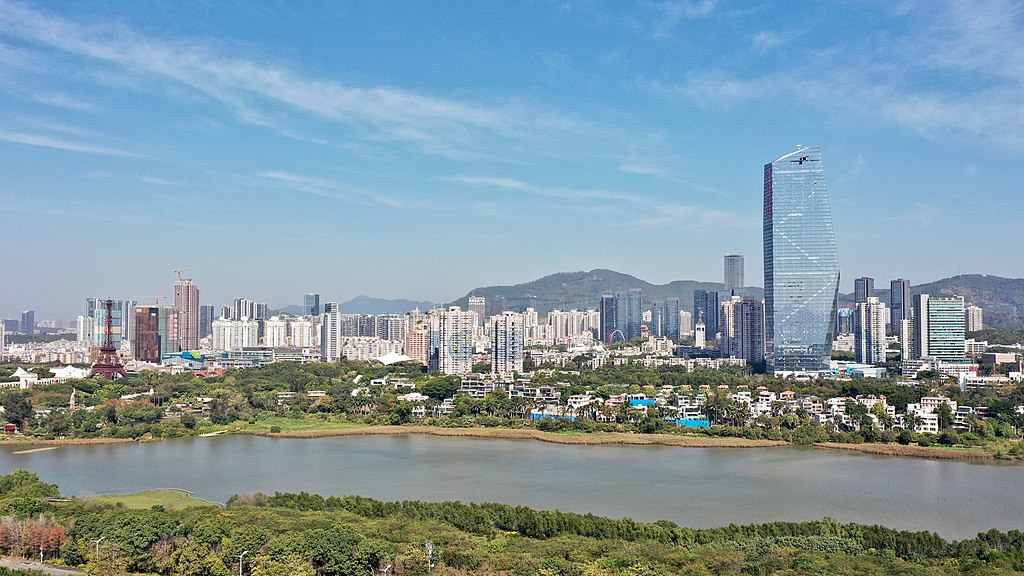This is a summary of the original article by Robert C. Thornett that may be found here
Shenzhen, the fastest-growing city in the history of the world, is a prime example of China’s Sponge City Program, which aims to prevent flooding and increase water supply in urban areas. The city is part of China’s Sponge Cities Program (SCP), a visionary attempt to tackle the twin crises of urban flooding and drought and implement innovative hydro-engineering solutions across China.
Shenzhen suffers from both floods and droughts. It is a tropical coastal city with a monsoon climate, which brings torrential rains every summer and near-desert level precipitation in winter, putting it among the top 10 world cities in potential future losses due to floods.
Sponge City Philosophy
One cause of China’s urban flooding problem is ultra-rapid urban growth which has led to a rush of ill-planned construction of infrastructure to accommodate the world’s largest rural-to-urban migration over the past two decades.
China wants its cities to be like sponges in that they will absorb water naturally, rather than keep water out with pavement and seawalls. Sponge cities will be able to absorb and capture storm-water in one place, where it is a problem, move it, and release it somewhere else where it is useful. This simultaneously reduces floods and increases the city’s water supply.
The sponge cities concept was invented by Chinese landscape architect, Professor Kong Jian Yu. Initially dismissed as a dream, the government picked up his sponge cities concept in 2015 and turned it into a national initiative.
The first round of 16 SCP pilot cities comprised those that had some of the worst flooding problems in China. Each city received over $50 million to invest in planning and infrastructure. Today, there are 30 sponge cities, and China aims to make 80 percent of the urban areas in these cities “sponge-like” by 2030.
The SCP covers a wide range of issues including eliminating urban waterlogging, restoring natural ecosystems, mitigating urban heat island effect and helping reduce global warming. For example, Shenzhen’s Mangrove Seashore Ecological Park is estimated to absorb over 900 tons of carbon dioxide each year.
Sponge City Principles
Three fundamental design principles underlie the SCP. They all involve capturing water at its source, slowing it down, and cleaning it to make it usable. First, as a sponge has many holes that absorb water, a sponge city has many lakes and retention ponds that collect water. Second, as water takes a meandering route through a sponge, sponge cities avoid having water move in straight lines. Instead, they slow the flow of water by diverting it into winding rivers and by surrounding water bodies with wetland vegetation. And third, sponge cities avoid constructing large buildings along waterfronts and instead turn coastlines into natural sinks where water can flow out to the ocean.
Sponge cities create floodable spaces that can not only survive but thrive during floods. They often contain wetland vegetation, elevated paths, and permeable pavement. For example, the pavement in Shenzhen Bay Park’s wide shoreline path, the Coastal Leisure Belt, allows water to infiltrate slowly and then percolate through a deep bed of gravel underneath, which slows it even more. When the water reaches an impermeable liner at the bottom, gravity leads it down a slight slope into pipes, which allow the city to store the water or direct it out to the ocean.
Sponge City Techniques
Shenzhen Bay Park, adjacent to the mangrove reserve, is a good example of sponge city techniques. Its 13-km coastline is free of large structures; major highways, structures, and residential areas are all behind the park, far from the ocean and safe from floods.
Futian Mangrove Nature Reserve, on the coast of Shenzhen Bay, is a giant wetland that is part of a Great Green Wall, which now helps guard some of the most densely-developed stretches of Shenzhen’s 260-kilometer coastline from floods. Covering a square kilometer, it houses 16 different species of mangrove trees, the only trees that can survive in saltwater. Some 200 bird species have been spotted there, and it has become a major stop for migratory birds.
Mangrove forests like these reduce both the height and the strength of incoming waves and storm surge, and are a thousand times cheaper to maintain than seawalls.
Greenways are one of the primary tools used by sponge cities for controlling the volume of storm-water runoff. Greenways are linear corridors of green space conserved for recreation and ecological protection. They absorb and filter water and connect communities, but they are also crucial to guiding runoff from flood-prone areas to sinks.
Thanks to the Sponge City Program, Shenzhen now has a high-density greenway network that totals over 2,300 meters in length, including green transport corridors, forests, and parks. Greenways have been essential to Shenzhen’s effort to convert one of its most ecologically-dysfunctional urban areas, Fenghuangcheng, into a national model of Sponge City construction.
Fenghuangcheng was an underdeveloped 25 sq. km area with heavy water pollution and flooding. But since 2016, it has added 47 km of greenways and 40 hectares of coastal ecological areas, permeable parking lots and pathways. These steps have reduced flooding and pollution, while lowering Fenghuangcheng’s average temperature from 39.7 degrees C to 37.8.
Greenways are also at the heart of two lakeside Sponge City parks in Shenzhen, both of which have become instant attractions: Talent Park and Xiangmi Park. Talent Park is a greenway loop of forest, trails, and open green spaces around a coastal lake. It acts as the sink for an extensive drainage canal network, which collects runoff from the ultra-dense Houhai neighborhood just inland. It has diverse plants that bloom in different seasons, so the park’s appearance changes throughout the year.
Xiangmi Park was created on the grounds of a former agricultural research center to which it added a new 6 km greenway with permeable trails, retention ponds, flower gardens, urban forests, and the Xiangmi Park Science Library, which is connected to the park by an elevated walkway through the treetops. Shenzhen calls Xiangmi Park its “green lungs.”
Template for the future
In the big picture, tropical coastal cities like Shenzhen – such as Bangkok, Mumbai and Karachi – are projected to experience the greatest increases in rainfall along with global warming. Several major cities that are facing similar hydro-engineering challenges are currently studying ways to adapt the sponge cities approach to their environments.
Shenzhen has a long way to go to manage urban flooding. But the hydro-engineering solutions mentioned above are helping it to create the necessary flood protection systems to catch up with its rapid growth.
The views expressed herein may not necessarily reflect the views of JI FAD and/or any of its affiliates






